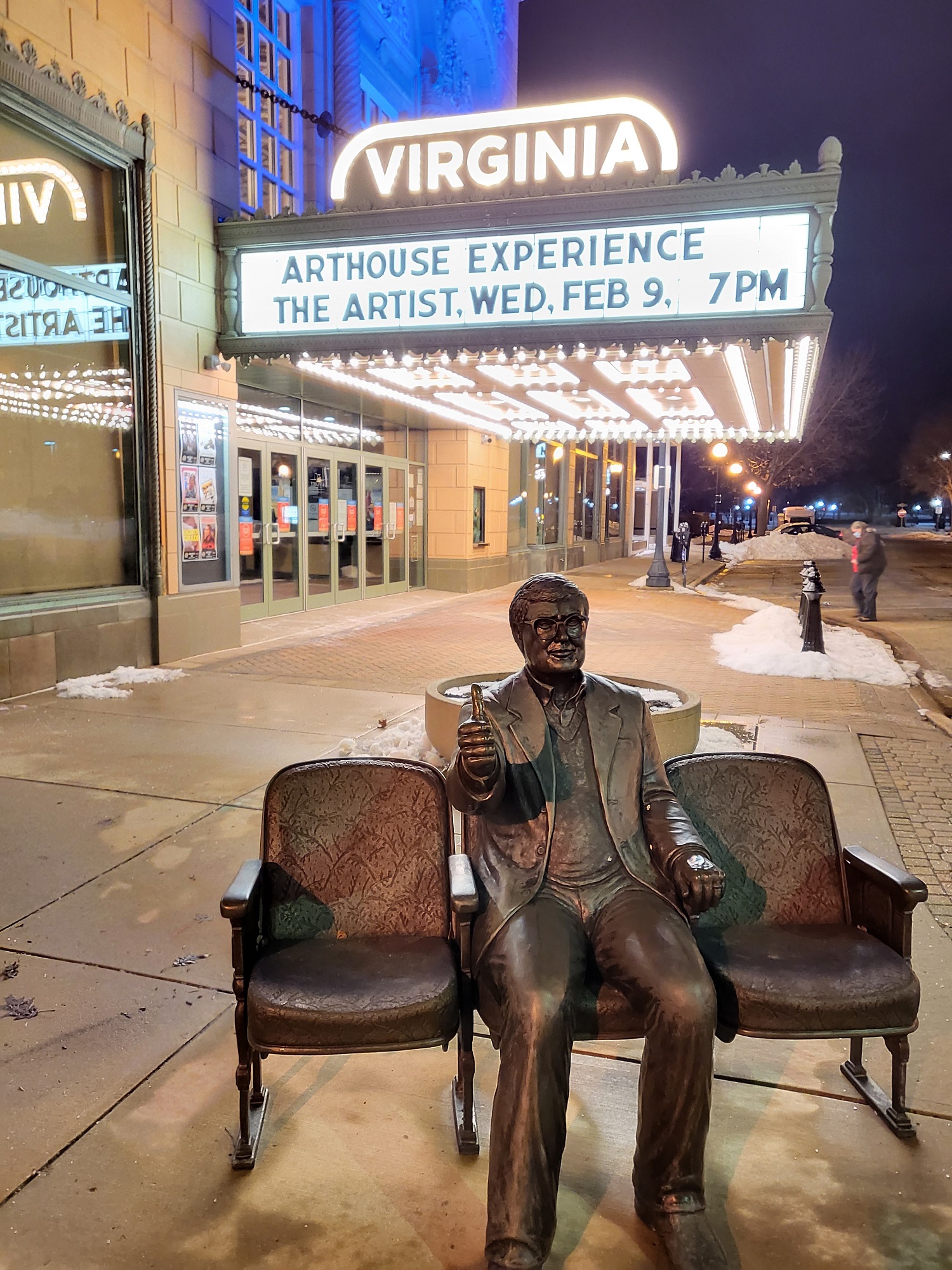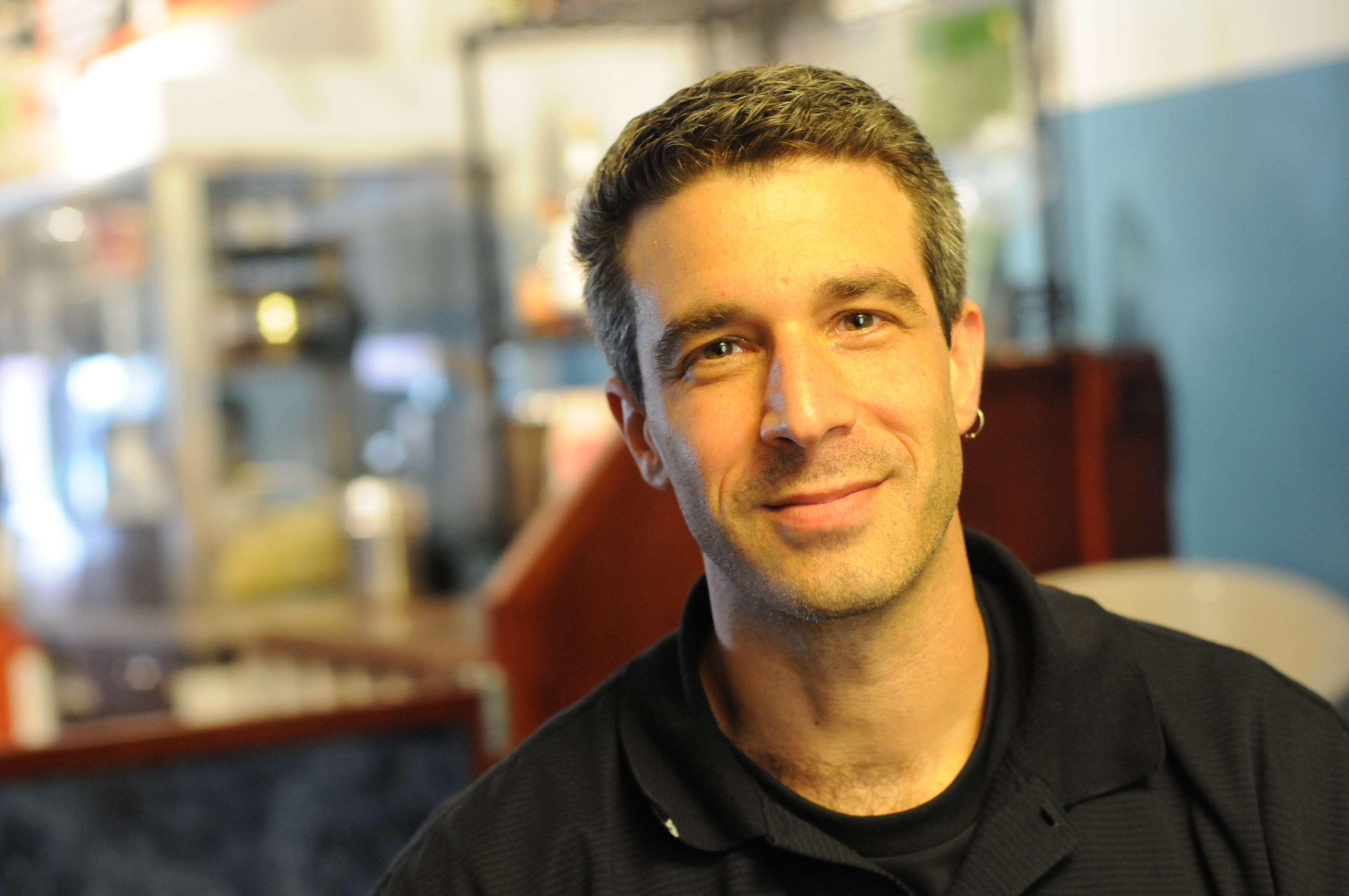Last week, I went to the Virginia Theatre to attend a screening of The Artist, one of my favorite movies of all time. The Artist was shown as part of the Virginia Theatre’s new “Arthouse Experience” series curated by local film buff Sanford Hess who also introduced the film and then hosted an after-screening talk. To say I’m glad I went would be a giant understatement.
I own a Blu Ray disc of the The Artist, I have my own screening room at home, and I’ve probably seen the film 4 or 5 times already. So why should I drive to a downtown Champaign movie theater, find parking and buy a ticket instead of just enjoying the movie at home with a glass of wine? The answer is that seeing a movie at The Virginia Theatre is a completely different experience. But seeing The Artist at the Virginia was a once-in-a-lifetime out-of-the-body experience like being in a dream sequence of a movie within a movie.
For those of you who haven’t seen the film well, let me explain. The Artist is set in the glory days of 1920s Hollywood and the opening scene is a major movie premiere at a beautiful movie palace, just like the one I was sitting in. We see the audience thoroughly enjoying the movie-within-the-movie, and when the movie ends, and the curtains close, and then… silence. Where is the applause? Did the movie bomb? Is there a technical problem in the projection booth? Then the movie cuts to a standing ovation with the movie premiere audience wildly clapping. But there’s still no sound? Well, duh, we’re watching a silent movie. It’s 1927 and movies with sound haven’t been invented yet.
The Virginia Theatre was built in 1921 and for its first decade or so, it showed silent films. So here I am sitting in this beautifully restored movie palace watching a silent movie in glorious black-and-white just like audiences did 100 years ago. For the rest of the screening, I felt like I was transported to a different time—a more innocent time when moving pictures was still a new invention and the flickering images on the silver screen was magic. After the post-screening talk, I chatted with Sanford Hess briefly and we agreed to do an email interview for Smile Politely to help promote this series.
Smile Politely: Where did the idea of an “arthouse experience” film series come about?
Sanford Hess: Credit the Virginia’s leadership, especially Steven Bentz, who saw a need in the community once the Art shut its doors in 2019. In 2020, Steven offered me the chance to curate the series because I operated the Art theater for three years, ending in 2012, including picking the movies. He agreed with my suggestion, and from the example of Ebertfest, that the series had to be about more than the movie—it’s the whole experience of going to the Virginia with other people who love movies.
SP: What is your personal definition of an “arthouse” film?
Hess: That’s one I really grappled with for this series. At the Art, the definition was “any film we could book”—so even films like Hobo With a Shotgun would be included, not that I recommend that film in any way. I used a similar definition for this series: “films that we would have booked at the Art,” meaning those that had a limited release and opened on less than 600 screens. But there are many genres within that range, and I’m not limiting the type of films any further than that.
SP: Screening The Artist at the Virginia was genius. I understand that you wanted to premiere the “Arthouse Experience” series with this movie. Why?
Hess: Thinking back to when I ran the Art Theater, I remembered the incredible audience response to The Artist, even though it’s a black & white silent film from a little-known French filmmaker. I couldn’t pass up the chance to share one of my favorite films—a film about 1920s Hollywood—in a gorgeous historic 1920s-era movie palace like the Virginia.
SP: Do you enjoy introducing the films?
Hess: Yes. It’s something I did at the Art initially to advertise upcoming shows, but I learned that people appreciate it when you pause before the movie and focus their attention on what is about to happen—as long as you don’t spoil the plot in any way.
SP: When you introduced The Artist, you talked about aspect ratios and masking which most moviegoers never really think about. Why is this important?
Hess: With The Artist, what’s noticeable is that the film is shot in the 4:3 aspect ratio that we associate with old films. Since it was released in 2011, when most films are widescreen, that was a conscious choice of the director to emulate the films of the 1920s that it celebrates. At the Virginia, they do it right: moveable curtains are used to “mask” the empty space on the sides of the screen. This is in contrast to the multiplexes, who have eliminated curtains on their screens as a cost-cutting move—so you’ll wind up with dead space on the sides or top and bottom of the screen. It’s those little details of film exhibition that make the difference.
SP: TV screens are getting bigger all the time. Is there really a difference between watching a movie on the big screen instead of at home?
Hess: It’s true, especially during the pandemic, we watched so much entertainment at home. TV size is part of it, but so is the availability of almost any movie through streaming services. The challenge is how to overcome that inertia of “I’ll just stay home and watch it.” One difference is the Virginia Theatre itself—a fully restored masterpiece of a theater right here in our town. Seeing a movie there isn’t like simply going to a multiplex! The other differences are things we do to highlight the content of the films: the intros and the post-screening discussions.

Photo by Elizabeth Hess.
SP: The Virginia Theatre has over 1400 seats. What is the best seat in the house?
Hess: At the Virginia I have three, depending on the show. In general, you should target a seat two-thirds of the way back in the center section downstairs, because that’s where the sound mix is optimal. When there’s a live event, I like to sit up front and see the people—so when the Alloy Orchestra plays at Ebertfest, I sit way up front on the right to observe them as much as I watch the film. Finally, I love the front row of the balcony in the center, where no one is blocking your view at all.
SP: I watch at least one movie a day, how about you?
Hess: I wish! It’s about one or two a week for me, and even less now that the Chicago Bulls are having a good season. During the worst of the pandemic, like so many others I was watching movies at a high rate, now I’m happy to see fewer if it means seeing them in a theater.
SP: So what’s the next movie on the schedule?
Hess: Adaptation is scheduled next for Wednesday, February 23th at 7 p.m. Thinking about films at Ebertfest from the past, I was inspired by how much the audience loved Charlie Kaufman’s Synecdoche, New York—and I’ve always thought Adaptation was one of his overlooked films. Although Kaufman didn’t direct it, his screenplay for the film broke some new creative ground and gave Nicholas Cage one of most memorable roles.
SP: What other films are you looking forward to seeing again on a big screen?
Hess: All of them! But for a big-screen experience The Royal Tenenbaums will be amazing for the music and the way Wes Anderson fills the whole frame with visuals. Given Wes Anderson’s popularity now, there could be some fans who haven’t seen The Royal Tenenbaums– or at least not in a theater. But please circle this date on your calendar: May 25th for Bo Burnham’s film Eighth Grade. It’s a touching and thoughtful exploration of that age—and for a first feature film (with an unknown lead) the quality is incredible. The whole list of upcoming films is available right here.
SP: What titles do you have in mind for part two of the series?
Hess: I wish I could share the list, but we’re still in the process of finding out which ones are available. The industry has changed and companies with streaming platforms are not allowing their back catalog films to be exhibited. Also, films that were produced by streaming services like Netflix are often unavailable, too. We hope to have next year’s schedule announced by summer.
SP: The Virginia Theatre is such a special place and we are so lucky that this venue is thriving in our community. I love seeing movies on their giant 52-foot screen and I’m kinda jealous that you get to program this series.
Hess: Definitely nothing about my day job as an IT Director prepared me for this! My past experience operating the Art Theater taught me about selecting films, though. The key strategy I learned is to pick films for the audience, not my own tastes. Champaign Park District has done such a great job restoring this theater and Steven Bentz and his team are such professionals when it comes to proper motion picture exhibition. The Virginia is a perfect place to see movies. They have an incredible sound system and are so well equipped to handle any format whether it’s digital or film, 35mm or 70mm. That’s rare today and you’re right—we are very lucky indeed.
When he is not watching one film a day, Paul Young likes to travel the world seeking good things to eat. So far, he has eaten his way through 22 countries and he loves to share his culinary discoveries with cooking classes.








